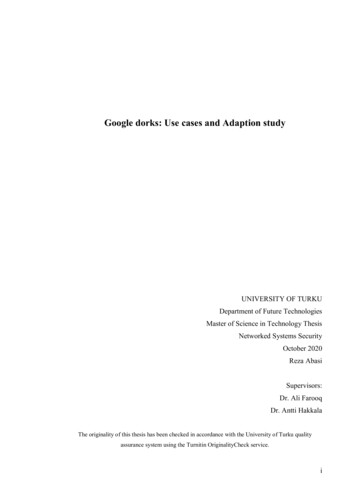
Transcription
Building Software Systems at Google andLessons LearnedJeff Deanjeff@google.com
Plan for Today Evolution of various systems at Google– computing hardware– core search systems– infrastructure software Techniques for building large-scale systems– decomposition into services– design patterns for performance & reliability– Joint work with many, many people
Google Web Search: 1999 vs. 2010 # docs: tens of millions to tens of billionsqueries processed/day:per doc info in index:update latency: months to tens of secsavg. query latency: 1s to 0.2s More machines * faster machines:
Google Web Search: 1999 vs. 2010 # docs: tens of millions to tens of billionsqueries processed/day:per doc info in index:update latency: months to tens of secsavg. query latency: 1s to 0.2s More machines * faster machines: 1000X
Google Web Search: 1999 vs. 2010 # docs: tens of millions to tens of billionsqueries processed/day:per doc info in index:update latency: months to tens of secsavg. query latency: 1s to 0.2s More machines * faster machines: 1000X 1000X
Google Web Search: 1999 vs. 2010 # docs: tens of millions to tens of billionsqueries processed/day:per doc info in index:update latency: months to tens of secsavg. query latency: 1s to 0.2s More machines * faster machines: 1000X 1000X 3X
Google Web Search: 1999 vs. 2010 # docs: tens of millions to tens of billionsqueries processed/day:per doc info in index:update latency: months to tens of secsavg. query latency: 1s to 0.2s More machines * faster machines: 1000X 1000X 3X 50000X
Google Web Search: 1999 vs. 2010 # docs: tens of millions to tens of billionsqueries processed/day:per doc info in index:update latency: months to tens of secsavg. query latency: 1s to 0.2s More machines * faster machines: 1000X 1000X 3X 50000X 5X
Google Web Search: 1999 vs. 2010 # docs: tens of millions to tens of billionsqueries processed/day:per doc info in index:update latency: months to tens of secsavg. query latency: 1s to 0.2s More machines * faster machines: 1000X 1000X 3X 50000X 5X 1000X
Google Web Search: 1999 vs. 2010 # docs: tens of millions to tens of billionsqueries processed/day:per doc info in index:update latency: months to tens of secsavg. query latency: 1s to 0.2s More machines * faster machines: 1000X 1000X 3X 50000X 5X 1000XContinuous evolution:– 7 significant revisions in last 11 years– often rolled out without users realizing we’ve made majorchanges
“Google” Circa 1997 (google.stanford.edu)
Research Project, circa 1997queryFrontend Web ServerDoc serversIndex serversI0I1I2Index shardsIND0D1Doc shardsDM
Basic Principles Index Servers:– given (query) return sorted list of docid, score pairs– partitioned (“sharded”) by docid– index shards are replicated for capacity– cost is O(# queries * # docs in index)
Basic Principles Index Servers:– given (query) return sorted list of docid, score pairs– partitioned (“sharded”) by docid– index shards are replicated for capacity– cost is O(# queries * # docs in index) Doc Servers– given (docid, query) generate (title, snippet)– snippet is query-dependent– map from docid to full text of docs (usually on disk)– also partitioned by docid– cost is O(# queries)
“Corkboards” (1999)
Serving System, circa 1999Cache serversqueryC0Frontend Web ServerAd SystemDoc ndex shardsReplicasReplicasIndex serversC1Doc shardsCK
Caching in Web Search Systems Cache servers:– cache both index results and doc snippets– hit rates typically 30-60% depends on frequency of index updates, mix of query traffic, levelof personalization, etc Main benefits:– performance! a few machines do work of 100s or 1000s– much lower query latency on hits queries that hit in cache tend to be both popular and expensive(common words, lots of documents to score, etc.) Beware: big latency spike/capacity drop when indexupdated or cache flushed
Indexing (circa 1998-1999) Simple batch indexing system– No real checkpointing, so machine failures painful– No checksumming of raw data, so hardware bit errorscaused problems Exacerbated by early machines having no ECC, no parity Sort 1 TB of data without parity: ends up "mostly sorted" Sort it again: "mostly sorted" another way “Programming with adversarial memory”– Developed file abstraction that stores checksums ofsmall records and can skip and resynchronize aftercorrupted records
Google Data Center (2000)
Google Data Center (2000)
Google Data Center (2000)
Google (new data center 2001)
Google Data Center (3 days later)
Increasing Index Size and Query Capacity Huge increases in index size in ’99, ’00, ’01, .– From 50M pages to more than 1000M pages At same time as huge traffic increases– 20% growth per month in 1999, 2000, .– . plus major new partners (e.g. Yahoo in July 2000 doubledtraffic overnight) Performance of index servers was paramount– Deploying more machines continuously, but.– Needed 10-30% software-based improvement every month
Dealing with GrowthqueryFrontend Web ServerAd SystemCache serversCache ServersDoc ServersIndex serversI1I2I0I1I2ReplicasI0Index shards
Dealing with GrowthqueryFrontend Web ServerAd SystemCache serversCache ServersDoc ServersIndex serversI1I2I3I0I1I2I3ReplicasI0Index shards
Dealing with GrowthqueryFrontend Web ServerAd SystemCache serversCache ServersDoc ServersReplicasIndex serversI0I1I2I3I0I1I2I3I0I1I2I3Index shards
Dealing with GrowthqueryFrontend Web ServerAd SystemCache serversCache ServersDoc ServersReplicasIndex serversI0I1I2I3I4I0I1I2I3I4I0I1I2I3I4Index shards
Dealing with GrowthqueryFrontend Web ServerAd SystemCache serversCache ServersDoc ServersReplicasIndex x shards
Dealing with GrowthqueryFrontend Web ServerAd SystemCache serversCache ServersDoc ServersReplicasIndex I2I3I4I10Index shards
Dealing with GrowthqueryCache serversFrontend Web ServerAd SystemCache ServersDoc ServersReplicasIndex 10I60I0I1I2I3I4I10I60Index shards# of disk seeks isO(#shards*#terms/query)
Dealing with GrowthqueryCache serversFrontend Web ServerAd SystemCache ServersDoc ServersReplicasIndex 10I60I0I1I2I3I4I10I60Index shards# of disk seeks isO(#shards*#terms/query)Eventually have enoughreplicas so that totalmemory across all indexmachines can hold ONEentire copy of index inmemory
Early 2001: In-Memory IndexCache serversqueryFrontend Web ServerAd SystemCache ServersDoc I14I12I13I14Shard 0Shard 1Shard 2Index shardsShard NIndex servers
In-Memory Indexing Systems Many positives:– big increase in throughput– big decrease in query latency especially at the tail: expensive queries that previously neededGBs of disk I/O became much faster and cheapere.g. [ “circle of life” ]
In-Memory Indexing Systems Many positives:– big increase in throughput– big decrease in query latency especially at the tail: expensive queries that previously neededGBs of disk I/O became much faster and cheapere.g. [ “circle of life” ] Some issues:– Variance: query touches 1000s of machines, not dozens e.g. randomized cron jobs caused us trouble for a while– Availability: 1 or few replicas of each doc’s index data Availability of index data when machine failed (esp for importantdocs): replicate important docs Queries of death that kill all the backends at once: very bad
Canary Requests Problem: requests sometimes cause server process to crash– testing can help reduce probability, but can’t eliminate If sending same or similar request to 1000s of machines:– they all might crash!– recovery time for 1000s of processes pretty slow Solution: send canary request first to one machine– if RPC finishes successfully, go ahead and send to all the rest– if RPC fails unexpectedly, try another machine(might have just been coincidence)– if fails K times, reject request Crash only a few servers, not 1000s
Query Serving System, 2004 editionRequestsCache serversRoot ParentServers RepositoryManager FileLoadersGFSLeafServersRepositoryShards
Query Serving System, 2004 editionRequestsCache serversRoot Parent Multi-level tree forServers query distribution RepositoryManager FileLoadersGFSLeafServersRepositoryShards
Query Serving System, 2004 editionRequestsCache serversRoot RepositoryManagerParent Multi-level tree forServers query distribution Leaf servers handle both index& doc requests from in-memorydata structures FileLoadersGFSLeafServersRepositoryShards
Query Serving System, 2004 editionRequestsCache serversRoot RepositoryManagerParent Multi-level tree forServers query distribution Leaf servers handle both index& doc requests from in-memorydata structures Coordinates indexswitching as new shardsbecome available FileLoadersGFSLeafServersRepositoryShards
Features Clean abstractions:– Repository– Document– Attachments– Scoring functions Easy experimentation– Attach new doc and index data without full reindexing Higher performance: designed from ground up toassume data is in memory
New Index Format Old disk and in-memory index used two-level scheme:– Each hit was encoded as (docid, word position in doc) pair– Docid deltas encoded with Rice encoding– Very good compression (originally designed for disk-based indices),but slow/CPU-intensive to decode New format: single flat position space– Data structures on side keep track of doc boundaries– Posting lists are just lists of delta-encoded positions– Need to be compact (can’t afford 32 bit value per occurrence)– but need to be very fast to decode
Byte-Aligned Variable-length Encodings Varint encoding:– 7 bits per byte with continuation bit– Con: Decoding requires lots of branches/shifts/masks0 0000001 0 0001111 1 1111111 0 0000011 1 1111111 1 1111111 0 0000111115511131071
Byte-Aligned Variable-length Encodings Varint encoding:– 7 bits per byte with continuation bit– Con: Decoding requires lots of branches/shifts/masks0 0000001 0 0001111 1 1111111 0 0000011 1 1111111 1 1111111 0 0000111115511131071 Idea: Encode byte length using 2 bits– Better: fewer branches, shifts, and masks– Con: Limited to 30-bit values, still some shifting to decode00 000001 00 001111 01 111111 0000001111551110 111111 11111111 00000111131071
Group Varint Encoding Idea: encode groups of 4 32-bit values in 5-17 bytes– Pull out 4 2-bit binary lengths into single byte prefix
Group Varint Encoding Idea: encode groups of 4 32-bit values in 5-17 bytes– Pull out 4 2-bit binary lengths into single byte prefix00 000001 00 001111 01 111111 0000011110 111111 11111111 00000111
Group Varint Encoding Idea: encode groups of 4 32-bit values in 5-17 bytes– Pull out 4 2-bit binary lengths into single byte prefix00 000001 00 001111 01 111111 0000011100000110Tags10 111111 11111111 00000111
Group Varint Encoding Idea: encode groups of 4 32-bit values in 5-17 bytes– Pull out 4 2-bit binary lengths into single byte prefix00 000001 00 001111 01 111111 0000011110 111111 11111111 0000011100000110 00000001 00001111 11111111 00000001 11111111 11111111 00000001Tags115511131071
Group Varint Encoding Idea: encode groups of 4 32-bit values in 5-17 bytes– Pull out 4 2-bit binary lengths into single byte prefix00 000001 00 001111 01 111111 0000011110 111111 11111111 0000011100000110 00000001 00001111 11111111 00000001 11111111 11111111 00000001Tags115511131071 Decode: Load prefix byte and use value to lookup in 256-entry table:
Group Varint Encoding Idea: encode groups of 4 32-bit values in 5-17 bytes– Pull out 4 2-bit binary lengths into single byte prefix00 000001 00 001111 01 111111 0000011110 111111 11111111 0000011100000110 00000001 00001111 11111111 00000001 11111111 11111111 00000001Tags115511131071 Decode: Load prefix byte and use value to lookup in 256-entry table:00000110Offsets: 1, 2, 3, 5; Masks: ff, ff, ffff, ffffff
Group Varint Encoding Idea: encode groups of 4 32-bit values in 5-17 bytes– Pull out 4 2-bit binary lengths into single byte prefix00 000001 00 001111 01 111111 0000011110 111111 11111111 0000011100000110 00000001 00001111 11111111 00000001 11111111 11111111 00000001Tags115511131071 Decode: Load prefix byte and use value to lookup in 256-entry table:00000110Offsets: 1, 2, 3, 5; Masks: ff, ff, ffff, ffffff Much faster than alternatives:– 7-bit-per-byte varint: decode 180M numbers/second– 30-bit Varint w/ 2-bit length: decode 240M numbers/second– Group varint: decode 400M numbers/second
2007: Universal SearchqueryAd SystemFrontend Web ServerSuper rootLocalCache serversNewsVideoImagesWebIndexing ServiceBlogsBooks
Universal Search Search all corpora in parallel Performance: most of the corpora weren’t designed todeal with high QPS level of web search Mixing: Which corpora are relevant to query?– changes over time UI: How to organize results from different corpora?– interleaved?– separate sections for different types of documents?
System Software Evolution
Machines RacksClusters In-house rack design PC-class motherboards Low-end storage & networkinghardware Linux in-house software
The Joys of Real HardwareTypical first year for a new cluster: 1 network rewiring (rolling 5% of machines down over 2-day span) 20 rack failures (40-80 machines instantly disappear, 1-6 hours to get back) 5 racks go wonky (40-80 machines see 50% packetloss) 8 network maintenances (4 might cause 30-minute random connectivity losses) 12 router reloads (takes out DNS and external vips for a couple minutes) 3 router failures (have to immediately pull traffic for an hour) dozens of minor 30-second blips for dns 1000 individual machine failures thousands of hard drive failuresslow disks, bad memory, misconfigured machines, flaky machines, etc.Long distance links: wild dogs, sharks, dead horses, drunken hunters, etc.
The Joys of Real HardwareTypical first year for a new cluster: 1 network rewiring (rolling 5% of machines down over 2-day span) 20 rack failures (40-80 machines instantly disappear, 1-6 hours to get back) 5 racks go wonky (40-80 machines see 50% packetloss) 8 network maintenances (4 might cause 30-minute random connectivity losses) 12 router reloads (takes out DNS and external vips for a couple minutes) 3 router failures (have to immediately pull traffic for an hour) dozens of minor 30-second blips for dns 1000 individual machine failures thousands of hard drive failuresslow disks, bad memory, misconfigured machines, flaky machines, etc.Long distance links: wild dogs, sharks, dead horses, drunken hunters, etc.Reliability/availability must come from software!
Low-Level Systems Software Desires If you have lots of machines, you want to: Store data persistently– w/ high availability– high read and write bandwidth Run large-scale computations reliably– without having to deal with machine failures
MastersC0C5C1C2Chunkserver 1 ReplicasGoogle File System (GFS) DesignClientGFS MasterClientClientC1C5Misc. serversGFS MasterC3Chunkserver 2C0 C5C2Chunkserver NMaster manages metadataData transfers are directly between clients/chunkserversFiles broken into chunks (typically 64 MB)Chunks replicated across multiple machines (usually 3)
Google Cluster Software Environment Cluster is 5K-20K machines, typically one or handful of hw configurations File system (GFS or Colossus) cluster scheduling system are coreservices Typically 100s to 1000s of active jobs (some w/1 task, some w/1000s) mix of batch and low-latency, user-facing production jobs.LinuxLinuxCommodity HWCommodity HWMachine 1Machine N
Google Cluster Software Environment Cluster is 5K-20K machines, typically one or handful of hw configurations File system (GFS or Colossus) cluster scheduling system are coreservices Typically 100s to 1000s of active jobs (some w/1 task, some w/1000s) mix of batch and low-latency, user-facing production odity HWCommodity HWMachine 1Machine N
Google Cluster Software Environment Cluster is 5K-20K machines, typically one or handful of hw configurations File system (GFS or Colossus) cluster scheduling system are coreservices Typically 100s to 1000s of active jobs (some w/1 task, some w/1000s) mix of batch and low-latency, user-facing production unkserverschedulingdaemonLinuxLinuxCommodity HWCommodity HWMachine 1Machine NGFSmaster
Google Cluster Software Environment Cluster is 5K-20K machines, typically one or handful of hw configurations File system (GFS or Colossus) cluster scheduling system are coreservices Typically 100s to 1000s of active jobs (some w/1 task, some w/1000s) mix of batch and low-latency, user-facing production unkserverschedulingdaemonLinuxLinuxCommodity HWCommodity HWMachine 1Machine NGFSmasterChubbylock service
Google Cluster Software Environment Cluster is 5K-20K machines, typically one or handful of hw configurations File system (GFS or Colossus) cluster scheduling system are coreservices Typically 100s to 1000s of active jobs (some w/1 task, some w/1000s) mix of batch and low-latency, user-facing production jobsjob 1 job 3task taskchunkserver.schedulingmasterjob 12taskschedulingdaemonjob 7 job 3task task.chunkserverjob 5taskschedulingdaemonLinuxLinuxCommodity HWCommodity HWMachine 1Machine NGFSmasterChubbylock service
Problem: lots of data Example: 20 billion web pages x 20KB 400 terabytes One computer can read 50 MB/sec from disk– three months to read the web 1,000 hard drives just to store the web Even more to do something with the data
Solution: spread work over many machines Good news: same problem with 1000 machines, 3 hours Bad news: programming work– communication and coordination– recovering from machine failure– status reporting– debugging– optimization– locality Bad news II: repeat for every problem you want to solve
MapReduce History 2003: Working on rewriting indexing system:– start with raw page contents on disk– many phases: duplicate elimination, anchor text extraction, languageidentification, index shard generation, etc.– end with data structures for index and doc serving Each phase was hand written parallel computation:– hand parallelized– hand-written checkpointing code for fault-tolerance
MapReduce A simple programming model that applies to manylarge-scale computing problems– allowed us to express all phases of our indexing system– since used across broad range of computer science areas, plusother scientific fields– Hadoop open-source implementation seeing significant usage Hide messy details in MapReduce runtime library:– automatic parallelization– load balancing– network and disk transfer optimizations– handling of machine failures– robustness– improvements to core library benefit all users of library!
Typical problem solved by MapReduce Read a lot of dataMap: extract something you care about from each recordShuffle and SortReduce: aggregate, summarize, filter, or transformWrite the resultsOutline stays the same,User writes Map and Reduce functions to fit the problem
Example: Rendering Map TilesInputMapShuffleReduceOutputGeographicfeature listEmit feature to alloverlapping latitudelongitude rectanglesSort by key(key Rect.Id)Render tile usingdata for all enclosedfeaturesRendered tilesI-5(0, I-5)Lake Washington(1, I-5)WA-520(0, Lake Wash.)I-90(1, Lake Wash.) 0(0, I-5)(0, Lake Wash.)(0, WA-520) (0, WA-520)(1, I-90) 1(1, I-5)(1, Lake Wash.)(1, I-90)
MapReduce: Scheduling One master, many workers– Input data split into M map tasks (typically 64 MB in size)– Reduce phase partitioned into R reduce tasks– Tasks are assigned to workers dynamically– Often: M 200,000; R 4,000; workers 2,000 Master assigns each map task to a free worker– Considers locality of data to worker when assigning task– Worker reads task input (often from local disk!)– Worker produces R local files containing intermediate k/v pairs Master assigns each reduce task to a free worker– Worker reads intermediate k/v pairs from map workers– Worker sorts & applies user’s Reduce op to produce the output
Parallel ShuffleReduceReduceReducePartitionedoutput
Parallel ShuffleReduceReduceReducePartitionedoutputFor large enough problems, it’s more about disk andnetwork performance than CPU & DRAM
Task Granularity and Pipelining Fine granularity tasks: many more map tasks thanmachines– Minimizes time for fault recovery– Can pipeline shuffling with map execution– Better dynamic load balancing Often use 200,000 map/5000 reduce tasks w/ 2000machines
Fault tolerance: Handled via re-executionOn worker failure: Detect failure via periodic heartbeats Re-execute completed and in-progress map tasks Re-execute in progress reduce tasks Task completion committed through masterOn master failure: State is checkpointed to GFS: new master recovers &continuesVery Robust: lost 1600 of 1800 machines once, but finished fine
Refinement: Backup Tasks Slow workers significantly lengthen completion time– Other jobs consuming resources on machine– Bad disks with soft errors transfer data very slowly– Weird things: processor caches disabled (!!) Solution: Near end of phase, spawn backup copiesof tasks– Whichever one finishes first "wins" Effect: Dramatically shortens job completion time
Refinement: Locality OptimizationMaster scheduling policy: Asks GFS for locations of replicas of input file blocks Map tasks typically split into 64MB ( GFS block size) Map tasks scheduled so GFS input block replica are onsame machine or same rackEffect: Thousands of machines read input at localdisk speed Without this, rack switches limit read rate
MapReduce Usage Statistics Over TimeAug, ‘0429KMar, ‘06171KSep, '072,217KMay, ’104,474KAverage completion time (secs)634874395748Machine years used2172,00211,08139,121Input data read (TB)3,28852,254403,152946,460Intermediate data (TB)7586,74334,774132,960Output data written (TB)1932,97014,01845,720Average worker machines157268394368Number of jobs
Current Work: Spanner Storage & computation system that runs across many datacenters– single global namespace names are independent of location(s) of data fine-grained replication configurations– support mix of strong and weak consistency across datacenters Strong consistency implemented with Paxos across tablet replicas Full support for distributed transactions across directories/machines– much more automated operation automatically changes replication based on constraints and usage patterns automated allocation of resources across entire fleet of machines
Design Goals for Spanner Future scale: 105 to 107 machines, 1013 directories, 1018 bytes of storage, spread at 100s to 1000s oflocations around the world– zones of semi-autonomous control– consistency after disconnected operation– users specify high-level desires:“99%ile latency for accessing this data should be 50ms”“Store this data on at least 2 disks in EU, 2 in U.S. & 1 in Asia”
System Building Experiences and Patterns Experiences from building a variety of systems– A collection of patterns that have emerged– Not all encompassing, obviously, but good rules ofthumb
Many Internal Services Break large complex systems down into many services! Simpler from a software engineering standpoint– few dependencies, clearly specified– easy to test and deploy new versions of individual services– ability to run lots of experiments– easy to reimplement service without affecting clients Development cycles largely decoupled– lots of benefits: small teams can work independently– easier to have many engineering offices around the world e.g. google.com search touches 200 services– ads, web search, books, news, spelling correction, .
Designing Efficient SystemsGiven a basic problem definition, how do you choose "best"solution? Best might be simplest, highest performance, easiest to extend, etc.Important skill: ability to estimate performance of a system design– without actually having to build it!
Numbers Everyone Should KnowL1 cache reference0.5 nsBranch mispredict5 nsL2 cache reference7 nsMutex lock/unlock25 nsMain memory reference100 nsCompress 1K w/cheap compression algorithm 3,000 nsSend 2K bytes over 1 Gbps network20,000 nsRead 1 MB sequentially from memory250,000 nsRound trip within same datacenter500,000 nsDisk seek10,000,000 nsRead 1 MB sequentially from disk20,000,000 nsSend packet CA- Netherlands- CA150,000,000 ns
Back of the Envelope CalculationsHow long to generate image results page (30 thumbnails)?Design 1: Read serially, thumbnail 256K images on the fly30 seeks * 10 ms/seek 30 * 256K / 30 MB/s 560 ms
Back of the Envelope CalculationsHow long to generate image results page (30 thumbnails)?Design 1: Read serially, thumbnail 256K images on the fly30 seeks * 10 ms/seek 30 * 256K / 30 MB/s 560 msDesign 2: Issue reads in parallel:10 ms/seek 256K read / 30 MB/s 18 ms(Ignores variance, so really more like 30-60 ms, probably)
Back of the Envelope CalculationsHow long to generate image results page (30 thumbnails)?Design 1: Read serially, thumbnail 256K images on the fly30 seeks * 10 ms/seek 30 * 256K / 30 MB/s 560 msDesign 2: Issue reads in parallel:10 ms/seek 256K read / 30 MB/s 18 ms(Ignores variance, so really more like 30-60 ms, probably)Lots of variations:– caching (single images? whole sets of thumbnails?)– pre-computing thumbnails– Back of the envelope helps identify most promising
Know Your Basic Building BlocksCore language libraries, basic data structures, protocol buffers,GFS, BigTable, indexing systems, MapReduce, Not just their interfaces, but understand theirimplementations (at least at a high level)If you don’t know what’s going on, you can’t do decentback-of-the-envelope calculations!
Designing & Building InfrastructureIdentify common problems, and build software systems toaddress them in a general way Important to not try to be all things to all people– Clients might be demanding 8 different things– Doing 6 of them is easy– handling 7 of them requires real thought– dealing with all 8 usually results in a worse system more complex, compromises other clients in trying to satisfyeveryone
Designing & Building Infrastructure (cont)Don't build infrastructure just for its own sake: Identify common needs and address them Don't imagine unlikely potential needs that aren't really thereBest approach: use your own infrastructure (especially at first!) (much more rapid feedback about what works, what doesn't)
Design for GrowthTry to anticipate how requirements will evolvekeep likely features in mind as you design base systemDon’t design to scale infinitely: 5X - 50X growth good to consider 100X probably requires rethink and rewrite
Pattern: Single Master, 1000s of WorkersMastersWorker 1Replicas Master orchestrates global operation of system– load balancing, assignment of work, reassignment whenmachines fail, etc.– . but client interaction with master is fairly minimalMisc. serversMasterClientMasterWorker 2ClientClientWorker N Examples:– GFS, BigTable, MapReduce, file transfer service, clusterscheduling system, .
Pattern: Single Master, 1000s of Workers (cont) Often: hot standby of master waiting to take over Always: bulk of data transfer directly between clients and workers Pro:– simpler to reason about state of system with centralized master Caveats:– careful design required to keep master out of common case ops– scales to 1000s of workers, but not 100,000s of workers
Pattern: Tree Distribution of Requests Problem: Single machine sending 1000s of RPCs overloads NICon machine when handling replies– wide fan in causes TCP drops/retransmits, significant latency– CPU becomes bottleneck on single machineRootLeaf 1Leaf 2Leaf 3Leaf 4Leaf 5Leaf 6
Pattern: Tree Distribution of Requests Solution: Use tree distribution of requests/responses– fan in at root is smaller– cost of processing leaf responses spread across many parents Most effective when parent processing can trim/combine leaf data– can also co-locate parents on same rack as leavesRootParentLeaf 1Leaf 2ParentLeaf 3Leaf 4Leaf 5Leaf 6
Pattern: Backup Requests to Minimize Latency Problem: variance high when requests go to 1000s of machines– last few machines to respond stretch out latency tail substantially Often, multiple replicas can handle same kind of request When few tasks remaining, send backup requests to other replicas Whichever duplicate request finishes first wins– useful when variance is unrelated to specifics of request– increases overall load by a tiny percentage– decreases latency tail significantly
Pattern: Backup Requests to Minimize Latency Problem: variance high when requests go to 1000s of machines– last few machines to respond stretch out latency tail substantially Often, multiple replicas can handle same kind of request When few tasks remaining, send backup requests to other replicas Whichever duplicate request finishes first wins– useful when variance is unrelated to specifics of request– increases overall load by a tiny percentage– decreases latency tail significantly Examples:– MapReduce backup tasks (granularity: many seconds)– various query serving systems (granularity: milliseconds)
Pattern: Multiple Smaller Units per Machine Problems:–
-recovery time for 1000s of processes pretty slow Solution: send canary request first to one machine -if RPC finishes successfully, go ahead and send to all the rest -if RPC fails unexpectedly, try another machine (might have just been coincidence) -if fails K times, reject request Crash only a few servers, not 1000s











